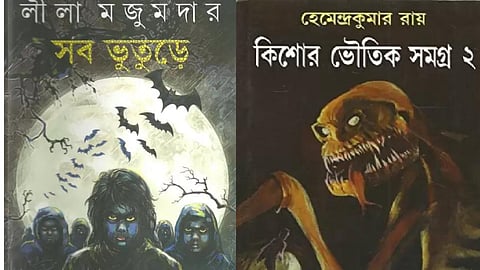
- HOMEGROWN WORLD
- #HGCREATORS
- #HGEXPLORE
- #HGVOICES
- #HGSHOP
- CAREERS
- ABOUT US
- CONTACT US

I have always been a huge fan of the art of translation and how it can bridge the language gaps and make so many unique and beautiful stories accessible to us. Because of translation, we can all enjoy literature from across the globe. One can argue that some things are lost in translation but without translation, readers or even film lovers would be in a dark mine without a head torch. Over the years, some remarkable works have been produced in the Bengali language, and one particular literary genre that fits the bill is horror.
Horror is like any literary theme like love or war. When we are reading a Victorian novel like Pride and Prejudice, we see how the idea of love is geopolitical and cultural. A Victorian woman falling in love with an English lord will never read the same as a 21st-century Indian boy being lovestruck with a girl, he met at an engineering college even though love is a universal theme. Similarly, when we are petrified by Frankensteinterin’s Monster as we read Mary Wollstonecraft’s brilliant 19th-century horror novel set in industrial London, it will not produce the same kind of horror as Rabindranath Tagore’s Kadambini, a widow called who dies suddenly and comes back to life, just a few hours later.
The creeping pangs of terror in your spine as you begin flipping through the pages of a horror story— the unpleasant sense of calm before the eerie— the mixed feeling of being frightened but unable to put down the book—the twists and turns of an incisively frightful journey— the unexpected conclusion that leaves you gasping for breath and consequently, afraid of going to the washroom. It's the process that horror lovers go through while reading a good horror story that makes it so thrilling.
Horror stories essentially bring out the culture and region from which it originates. Whenever we encounter a djinn in a horror story, we immediately think of its origin in Arabic or Persian mythology. Similarly, Bengali literature has created some interesting and frightening ghosts over the years. These figures or apparitions mainly originate from village folklore where superstitions and fear of the occult are still majorly prevalent. One horrifying persona of a Bengali ghost is the Shakchunni. It is a spirit of a married Hindu woman who wears a special kind of traditional shell bangles (called Shankha in Bengali) in their hands. Another terrifying one is Aili, whose legends are popular in rural areas of Bangladesh. They are ghosts who guide unwary travelers in the wrong direction by inducing hallucinations until they down into a river or lake. Bengalis have their version of witches called Dainees and there is another notorious apparition called Mamdo Bhoot, who are ghosts of Muslims and they kill their victims by twisting their necks. There are hundreds of other ghosts in the Bengali literary canon, with their distinct set of appearances and unique method of haunting.
Thanks to translation, we can experience horror stories from around the world. One of the best Bengali horror writers is the Bangladeshi novelist, Humayun Ahmed. His anthologies of horror stories Adbhut Shob Golpo and Nirbachito Bhuter Golpo are legendary and unputdownable. Rabindranath Tagore’s Nishithe and Bibhutibhushan Bandyopadhyay’s Taranath Tantriker Golpo are also some of the most intriguing horror tales, now available in English.
If you’re looking to embark on a horror-filled, exhilarating journey into the world of Bengali novels, a good place to start would be a recently published work called An Anthology of the Best Ghost Stories from Bengal. It includes stories selected & translated by Barnali Saha and has been published by Beebooks. The anthology features writers during 1838-1938 and the curated focus on the specifics of the characters, spectral or otherwise, gender, socio-cultural and political narrative of the century. It includes the works of Rabindranath Tagore, Bankim Chandra Chattopadhyay, Bibhutibhushan Bandyopadhyay, Syed Mustafa Siraj, Atin Bandopadhyay, Bonophool, and Hemendra Kumar Roy among others.
You can order the book here.
If you enjoyed reading this, here's more from Homegrown:
Anubhav G's Loka is Bringing Worldbuilding, Grit, & Horror To Indian Comic Books
Ruskin Bond’s Chilling Horror Stories Come To Life In A New Web Series
A Homegrown Halloween Guide To Horror Films Perfect For The Spooky Season
